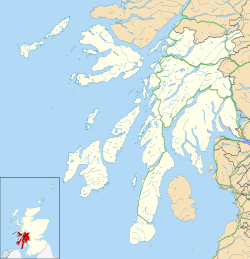Knocknafenaig
| |
|---|---|
 The ruins of Knocknafenaig | |
Location within Argyll and Bute | |
| Civil parish | |
| Council area | |
| Country | Scotland |
| Sovereign state | United Kingdom |
| Police | Scotland |
| Fire | Scottish |
| Ambulance | Scottish |
Knocknafenaig (Scottish Gaelic : Cnoc na Fennaig) is a ruined township on the Isle of Mull, Scotland.
Located in the south-western portion of the island known as the Ross of Mull, Knocknafenaig is an extremely well preserved township that shows many characteristics of the 19th-century and early 20th-century living conditions. Although it is believed to have had medieval settlements, almost no evidence remains of these due to their organic nature. Among the many ruins is a well preserved corn-drying kiln and house, known as Braigh. The Braigh is the last remaining thatched building in the Ross of Mull and was inhabited until the mid-1980s.
The name Cnoc na Fennaig translates as "Hill of the Lazybeds" (this being a reference to the type of cultivation used throughout the area).
In 1779 the township had a population of 70. After the Highland Clearances and the Potato Famine in the mid-19th century the township became increasingly deserted. After World War I Knocknafenaig was divided into six crofts for returning servicemen. Eventually the six crofts were combined to become Ardachy Farm.

